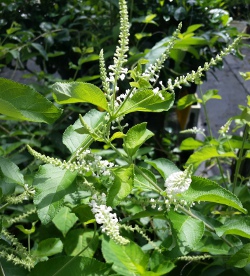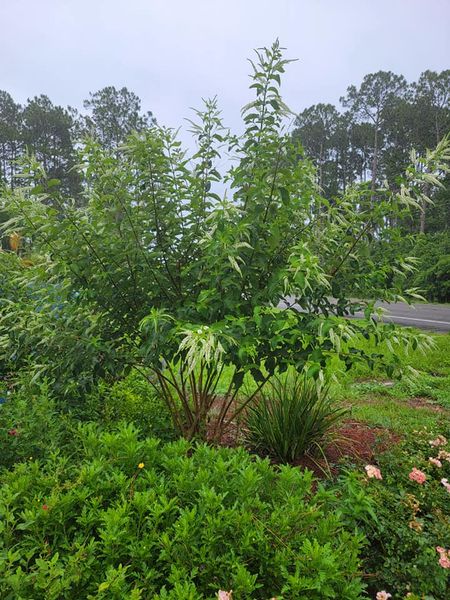S & J Nursery’s Guide to growing
Almond Bush
for Northeast Florida,
Jacksonville | St. Augustine area Landscapes
(Aloysia Virgata)
Origins of Almond Bush / Aloysia Virgata:
– A perennial plant in the family Verbenaceae native to Argentina. Found from Central Argentina up to Brazil and Peru, also in Yucatán, southeastern United States, and Texas. The common names ” Sweet Almond Bush ” and ” Sweet Almond Verbena ” come from the flowers that smell of a powerful, honeyed almond or vanilla like fragrance.
– Flowers stay on the bush all summer long and well into fall , making sweet almonds good sources of nectar for butterflies and birds

Preferred Exposure of Almond Bush / Aloysia Virgata:
– Almond Bush will prefer a full sun location (a minimum of 6-8 hours of direct sun a day) or partial shade in our North Florida | Jacksonville| St. Augustine area landscapes to perform at their best.
Foliage of the Almond Bush / Aloysia Virgata :
– Sweet Almond Bush is a fast-growing woody large shrub or small tree. In zones 10-11 it can be grown as a tree or shrub. Semi-evergreen in our subtropical climate zone for Jacksonville and St. Augustine areas of Northeast Florida and deciduous in areas farther North into zone 8 and can be grown as a perennial. Can tolerate great heat.
– Slightly glossy green leaves with serrated leaf margins.
– It is commonly used in places like butterfly gardens, because the smell of the bush attracts insects to its flowers. Following this same trend, it also works well as part of a garden, as it brings pollinators like bees to the bush, and encourages pollination to other nearby plants. The Sweet Almond Bush can also just be used as a nice background shrub to other garden plants.
Soil Preference and Salt tolerance of Almond Bush / Aloysia Virgata:
– Almond Bush will prefer moist well drained soils but is quite drought tolerant when established into the landscape During the first year of growth, make sure to water your bush regularly to keep the soil wet. This helps with root growth.
– not particular about soil components and grow equally as well in sandy soils as they do in clay.
– Almond bush shrubs have a moderate salt tolerance and can be utilized for coastal
plantings.
Size Variance of Almond Bush / Aloysia Virgata :
–Almond Bush / Aloysia Virgata can reach sizes of 8-15+ feet High | 8-12 feet Wide but are most often kept to about 5 feet High | 3 feet Wide with annual or semi annual pruning in the North Florida |
Jacksonville | St. Augustine areas gardens.
– They bloom on new growth so pruning frequently will not only keep its size in check but increase blooms.
space plants at a minimum of 3 ft – 8 ft from the center of one plant to the center of another.

Growth Habit of Almond Bush / Aloysia Virgata :
– Almond Bush is an upright to rounded shrub/tree with rapid growth rate.
– Unlike high-maintenance shrubs, sweet almonds do not need deadheading. Hard pruning is often done to keep the plant full and compact. Pruning should take place right after the bloom time is over i.e., late summers. Avoid pruning in winter as this may cut off next year’s buds.
Growth Rate of the Almond Bush / Aloysia Virgata :
– Rapid growing shrub quickly establishes itself into the landscape. Almond bush may freeze to the ground during a hard freeze and will reemerge from the ground growing 12″+ in a growing season.
Blooms of the Almond Bush plant:
– Sweet almond bushes develop long, pointy spiked flower clusters with pretty white blooms. These flowers are supremely fragrant and fill the garden with a sweet scent of vanilla or almonds. Sweet almond flowers have an extensive bloom period. They stay abloom throughout spring and summer and well into fall in the North Florida | Jacksonville | St. Augustine areas gardens
Water Requirements of Almond Bush / Aloysia Virgata :
– Sweet almond bushes are drought-tolerant. They easily thrive in hot climates and won’t need regular watering. Requires little water to keep growing happy and healthy. Water the bush twice a month, especially during the dry weather conditions.
Remember to check water needs daily after planting until the plant gets rooted in and growing on its own.
Here is a link for S & J Nursery Guide to watering large shrubs and trees.
Watering Newly Planted Larger Shrubs and Trees
Butterfly or Bird Attracting:
– Flowers stay on the bush all summer long and well into fall, making sweet almonds good sources of nectar for butterflies, bees and hummingbirds.

Best Uses For Almond Bush / Aloysia Virgata:
– An excellent shrub for a butterfly garden or any spot where an insect-attracting, fragrant plant is needed. It is best used as an accent or background shrub. Small white flowers clusters perfume the landscape.
– Unlike high-maintenance shrubs, sweet almonds do not need deadheading. Hard pruning is often done to keep the plant full and compact. Pruning should take place right after the bloom time is over i.e., late summers. Avoid pruning in winter as this may cut off next year’s buds.
Care of S & J Nursery’s North Florida | Jacksonville | St. Augustine Almond Bush / Aloysia Virgata Shrubs:
– Almond Bush should be pruned annually after bloom time is over in late summers. Do not be afraid to trim, they resprout quickly and bloom on that new growth! Pruning will not only keep its size in check but increase blooms.
– Almond Bush shrubs can be planted in the North Florida | Jacksonville | St. Augustine area at any time during the year. In normal and well draining soils dig the hole as deep as the root ball and two to three times as wide. Plant the top of the root ball level or slightly higher than the surrounding soils. Avoid planting in poorly drained soils.
– Check the plants water needs every day during the establishment period. For most 3 gallon size shrubs in the North Florida landscape in average soil, that is neither heavy clay that holds water or really sandy that will take 2-3 weeks of daily watering to ensure that your newly planted shrub will begin to put out new roots and grow into its new home happily. After the first few weeks begin tapering back your watering to every other day then every third day and so on until your newly planted items are flourishing without your assistance.
– Almond Bush does not require supplimental irrigation during time of excessive hear or drought. Almond Bush is drought tolerant once established in the landscape.
– IMPORTANT: If planting shrubs in heavy clay soils that hold allot of water after a rain or irrigating, remember to check the soil for moisture by sticking your fingers into the soil near the root ball of the newly planted shrub down to 2-3 inches. If it remains wet from the previous watering wait for the top 2-3 inches to dry out before watering again.
– IMPORTANT: When planting shrubs into poor sandy soils be sure to amend the planting hole by mixing compost or cow manure etc. with the native soil that will go back in the hole around the new plants root ball when installing your shrub material, this will not only give your new shrubs good soil to grow its new roots into but help it hold water.
– When planting shrubs from containers be sure to loosen the roots as much as possible pulling loose roots away from the root ball before installing your new plants, if the roots are to tight to easily loosen with your hands use a knife to cut a few slits into the root ball being careful to go all
the way from the top to the bottom and making the cut at least an inch deep. This will ensure that your plant will immediately begin to form new roots into its new surrounding soil.
Here is a link for S & J Nursery Guide to watering large shrubs and trees.
Watering Newly Planted Larger Shrubs and Trees
– Mulch newly planted shrubs whenever possible. Shrubs will benefit from a 3-4 inch layer of arborists wood chips, Pine bark or Pine Straw.
– Fertilize each spring with a shovelful of good garden compost or a mixture of Milorganite and a good quality slow release poly coated plant food like Stay Green or Osmocote. Be sure when fertilizing to sprinkle the fertilizer around the mulch circle underneath the foliage of the shrubs.

